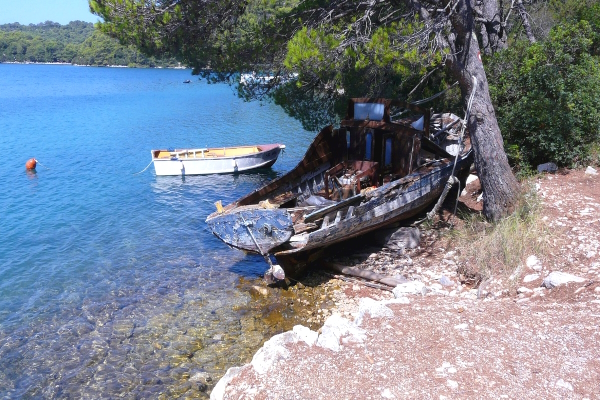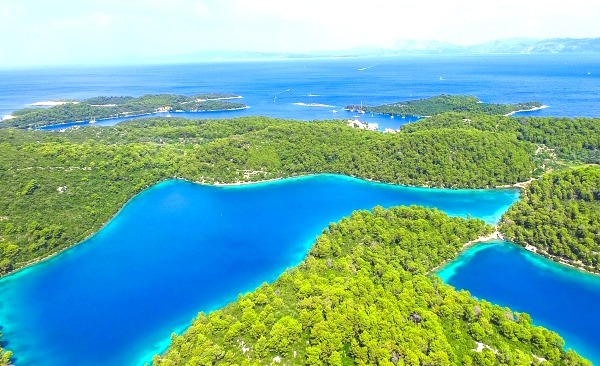Mljet is a beautiful island in the southern Adriatic Sea in Croatia. It is known for its natural beauty, lush forests, pristine beaches and crystal clear waters. The island also has many historical and cultural attractions such as ancient ruins, monasteries and churches. This article is about the history, geography and attractions of Mljet.
Boat tours to Mljet: There are several day tours by boat to Mljet, especially from Dubrovnik: Bookable on the well-known website Getyourguide.

History island Mljet
Mljet has a long and rich history. The island was first inhabited by the Illyrians, ancient Indo-Europeans who settled here and established a settlement in the 4th century BC. The Illyrians were later conquered by the Romans, who arrived in the 1st century BC and founded a colony on the island.
During the Middle Ages, Mljet was ruled by various powers, including the Byzantine Empire, the Kingdom of Croatia and the Republic of Dubrovnik. The island was of strategic importance as it was a major trading centre and controlled access to the nearby port of Dubrovnik.
In the 19th century, Mljet became part of the Austro-Hungarian Empire, which ruled the island until the end of the First World War. After the war, Mljet became part of Yugoslavia, and after the dissolution of Yugoslavia in the 1990s, it became part of Croatia.
Video Island Mljet – Youtube
Geography island Mljet
With an area of 98.01 square kilometres, Mljet is its eighth largest island in Croatia. It lies in the south of the Adriatic Sea, about 20 kilometres south of the city of Dubrovnik. Most of the island is densely forested and dotted with small towns and villages. The island of Mljet lies in the Adriatic Sea.
One of the special features of Mljet is the Mljet National Park, which occupies a large part of the island. This park is home to a diverse flora and fauna, including over 1,000 plant species, and is a popular destination for hikers and nature lovers. The lakes in the park are also home to a variety of fish, making it a popular place for fishing.
Another attraction worth seeing on Mljet is the Benedictine monastery on the island of St. Maria. This ancient monastery was founded in the 12th century and has been well preserved over the centuries. Visitors can explore the medieval architecture of the monastery and learn more about the fascinating history of this religious site.
History buffs can also take a look at Croatia’s past on Mljet. The island’s numerous ancient ruins and medieval towns offer a unique insight into the region’s rich cultural heritage. Visitors can explore the ruins of the Roman palace in Polače or stroll through the streets of the medieval town of Babino Polje.
Of course, no trip to Mljet would be complete without spending some time on the island’s beautiful beaches. The island offers a variety of beaches, ranging from secluded coves to large sandy beaches. Saplunara beach on the south-eastern tip of the island is one of the most popular beaches on Mljet, with its white sand and clear turquoise waters.
Mljet National Park
Mljet National Park is a nature reserve on the island of Mljet in southern Croatia. The park covers an area of 54 square kilometres, about one third of the total area of the island. The park was established in 1960 and is one of the first national parks in Croatia.
Boat trips to the island of Mljet and the national park: There are several day trips by boat to Mljet, mainly from Dubrovnik: Bookable on the well-known website Getyourguide.
One of the main features of the national park are the two salt lakes in the centre of the island, Veliko Jezero (Big Lake) and Malo Jezero (Small Lake). The lakes are connected by narrow channels and surrounded by dense forests, rocky cliffs and lush vegetation. The lake is a popular destination for swimming, kayaking and boating, and visitors can rent boats and kayaks to explore the lake on their own.

The park is also home to a variety of wildlife, including deer, wild boar, foxes and several species of birds. The park’s forests are particularly rich in bird species, with more than 100 species counted. The most common birds include woodpeckers, owls and birds of prey such as eagles and buzzards.
One of the most popular walks in the park is the trail that circles Lake Veliko Jezero. The trail is about 4.5 km long and takes about 2 hours. Along the way, hikers can enjoy breathtaking views of the lake and the surrounding forest. There are also several short hiking trails that lead to viewpoints and other attractions in the park.
In addition to its natural attractions, the park also has a rich cultural heritage. The island of Mljet has been inhabited since ancient times and there are several historical sites in the park, including a Roman palace and a Benedictine monastery. The island’s rich history is also reflected in its traditional architecture and cultural practices, which visitors can learn more about at the park’s visitor centre.
Overall, Mljet National Park is a must-see for anyone travelling to Croatia. With its beautiful lakes, lush forests and diverse wildlife, the park offers visitors of all ages a unique and unforgettable experience. Whether you enjoy hiking and swimming or simply enjoying the natural beauty of the island, Mljet National Park is well worth a visit.
Benedictine Monastery Mljet
The Benedictine Monastery is a historic religious institution located on the small island of St. Mary, which is part of the Mljet archipelago in southern Croatia. The monastery was founded in the 12th century, when the island was under the rule of the Republic of Dubrovnik, and was built in the Romanesque style. It is one of the oldest and best preserved monasteries in Croatia.
The monastery is located on the western side of the island and is surrounded by beautiful gardens and orchards. The main attraction of the monastery is the impressive church dedicated to the Assumption of the Virgin Mary. The church has beautiful frescoes and an impressive altar that allows visitors to explore the ornate interior.
In addition to the church, the monastery also houses a museum that displays various artefacts related to the history and religious heritage of the monastery. Visitors can learn about the daily life of the Benedictine monks who once lived in the monastery and the role it played in the religious and cultural life of the region.
The abbey is also known for its beautiful cloister, which consists of a series of columns and arches surrounding a peaceful garden. The cloister is a place of peace and tranquillity, perfect for contemplation and reflection.
Visitors to the monastery can take guided tours or explore the grounds on their own. The monastery is easily accessible by boat from several places on the island such as Pomena and Polace. The abbey is open to visitors from April to October and there is an entrance fee.
Overall, the Benedictine Abbey of St Mary’s Island is a fascinating and unique attraction that offers an insight into the rich religious and cultural heritage of the region.
Other sights on the island of Mljet
Odysseus Cave: Legend has it that the ancient Greek hero Odysseus sought refuge in this cave during a storm. It is located on the southern coast of the island and is known for its incredible rock formations and crystal clear waters.
Saplunara Beach: This beautiful sandy beach is located on the southeast coast of the island and is known for its crystal clear waters and tranquil atmosphere. It is a popular place for swimming, sunbathing and relaxing.
The island of St. Maria: This small island lies in the middle of another lake in the Mljet National Park and is the former seat of a Benedictine monastery. Visitors can take a boat to the island and explore the monastery complex with its church, monastery and museum.
Montaukuk Hill: This hill is the highest on the island and offers stunning views of the surrounding area. Visitors can climb to the top of the hill and enjoy the beautiful scenery of the island. Mljet Island Wine: The island of Mljet is known for its delicious wine made from local grape varieties. Visitors can visit the island’s wine cellars, taste the local wines and learn about the island’s winemaking traditions.
Boat trips to the island of Mljet and the national park: There are several day trips by boat to Mljet, mainly from Dubrovnik: Bookable on the well-known website Getyourguide.